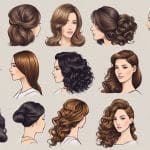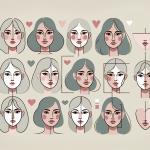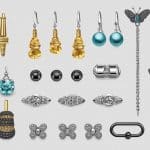Types Of Hair Color
Hair color is an essential aspect of one’s overall appearance, and it can significantly impact how a person looks and feels about themselves. Choosing the right hair color can be a daunting task, especially with the numerous options available in the market. Understanding the different types of hair color and their characteristics is crucial in making an informed decision.
Hair color is categorized into four main types: temporary, semi-permanent, demi-permanent, and permanent. Temporary hair color is ideal for people looking for a quick change in their hair color and lasts for a short period. Semi-permanent hair color lasts longer than temporary hair color, but it fades gradually after several washes. Demi-permanent hair color lasts longer than semi-permanent hair color and fades slowly over time. Permanent hair color is the most popular type and provides long-lasting results that do not fade quickly.
When choosing a hair color, it is essential to consider factors such as skin tone, eye color, and natural hair color. A hair color that complements these factors can enhance one’s overall appearance and make them feel more confident. Additionally, it is crucial to maintain the hair color by using the right products and techniques to prevent fading and damage.
Key Takeaways
- Hair color is categorized into four main types: temporary, semi-permanent, demi-permanent, and permanent.
- When choosing a hair color, it is essential to consider factors such as skin tone, eye color, and natural hair color.
- Maintaining the hair color by using the right products and techniques is crucial to prevent fading and damage.
Understanding Hair Color

Hair Color Science
Hair color is the pigmentation of hair follicles due to the presence of melanin. Melanin is produced by specialized cells called melanocytes, which are located in the hair follicles. Hair color is determined by the amount and type of melanin present in the hair follicles. There are two types of melanin: eumelanin and pheomelanin. Eumelanin is responsible for black and brown hair, while pheomelanin is responsible for red and blonde hair.
Levels and Undertones
Hair color can be classified into different levels and undertones. The level of hair color refers to how light or dark the hair is, while the undertone refers to the underlying tone of the hair color. The level of hair color ranges from 1 to 10, with 1 being the darkest black and 10 being the lightest blonde. The undertone of hair color can be warm, cool, or neutral. Warm undertones have a reddish or orange tint, cool undertones have a blue or green tint, and neutral undertones have a balance of warm and cool tones.
Understanding the natural hair color and undertone is important when choosing a hair color shade. If the natural hair color is warm, it is best to choose a warm hair color shade to complement the undertone. Similarly, if the natural hair color is cool, it is best to choose a cool hair color shade.
In conclusion, understanding the science of hair color and the different levels and undertones is crucial when choosing a hair color shade. It is important to choose a hair color shade that complements the natural hair color and undertone to achieve the desired look.
Types of Hair Color
When it comes to changing hair color, there are various types of hair color products available in the market. Each type of hair color has its own unique features, advantages, and disadvantages. In this section, we will discuss the different types of hair color and their characteristics.
Temporary Hair Color
Temporary hair color is a type of hair color that is designed to last for a short period of time, typically a few days to a week. This type of hair color is ideal for people who want to experiment with different hair colors without committing to a permanent change. Temporary hair color is available in various forms, such as hair chalk, sprays, and gels. This type of hair color is easy to apply and can be washed out easily with shampoo.
Demi-Permanent Hair Color
Demi-permanent hair color is a type of hair color that lasts longer than temporary hair color but not as long as permanent hair color. This type of hair color typically lasts for about six to eight weeks. Demi-permanent hair color is ideal for people who want to enhance their natural hair color or cover up gray hair. This type of hair color is gentle on the hair and does not contain harsh chemicals like ammonia or bleach.
Semi-Permanent Hair Color
Semi-permanent hair color is a type of hair color that lasts longer than temporary hair color but not as long as permanent hair color. This type of hair color typically lasts for about four to six weeks. Semi-permanent hair color is ideal for people who want to add a subtle change to their hair color or cover up gray hair. This type of hair color is easy to apply and does not require the use of a developer.
Permanent Hair Color
Permanent hair color is a type of hair color that is designed to last for a long period of time, typically several months. This type of hair color is ideal for people who want to make a drastic change to their hair color or cover up gray hair. Permanent hair color contains harsh chemicals like ammonia and bleach, which can damage the hair if not used correctly. It is recommended to have permanent hair color applied by a professional hairdresser.
Henna
Henna is a natural hair color that is made from the leaves of the henna plant. This type of hair color is ideal for people who want to avoid harsh chemicals and prefer a natural alternative. Henna is available in various shades, ranging from red to brown. Henna is a semi-permanent hair color that typically lasts for about four to six weeks.
Hair Dye
Hair dye is a type of hair color that is designed to permanently change the hair color. Hair dye contains harsh chemicals like ammonia and bleach, which can damage the hair if not used correctly. It is recommended to have hair dye applied by a professional hairdresser.
Hair Chalk
Hair chalk is a temporary hair color that is available in various colors. This type of hair color is ideal for people who want to experiment with different hair colors without committing to a permanent change. Hair chalk is easy to apply and can be washed out easily with shampoo.
Bleach
Bleach is a type of hair color that is used to lighten the hair. Bleach contains harsh chemicals like ammonia and hydrogen peroxide, which can damage the hair if not used correctly. It is recommended to have bleach applied by a professional hairdresser.
In conclusion, there are various types of hair color products available in the market. Each type of hair color has its own unique features, advantages, and disadvantages. It is important to choose the right type of hair color based on individual preferences and hair type.
Color Selection and Maintenance
Choosing the Right Shade
Choosing the right shade of hair color is essential to achieving the desired look. It is important to consider the natural hair color, skin tone, and the desired level of intensity when selecting a hair color. For instance, if a person has light skin, they may want to opt for a lighter shade of blonde or golden brown, while those with darker skin may prefer a darker shade of brown or red.
It is also important to consider the maintenance required for the chosen shade. Vibrant shades such as red or blonde may require more frequent touch-ups to maintain their intensity. On the other hand, darker shades such as brown may be easier to maintain as they tend to fade less quickly.
Caring for Colored Hair
Maintaining hair color can be challenging, but with the right hair care routine, it can be achieved. One of the most important things to consider is the type of shampoo and conditioner used. Sulfate-free shampoos and conditioners are recommended as they are less likely to strip the hair of its color.
Additionally, it is important to protect the hair from heat styling tools such as flat irons and curling irons, which can cause the color to fade. Using a heat protectant spray can help to minimize damage and protect the color.
Finally, regular touch-ups are necessary to maintain the color’s vibrancy. It is recommended to touch up the roots every four to six weeks, depending on the rate of hair growth.
By following these tips, it is possible to maintain hair color and keep it looking vibrant and healthy for longer.
Hair Color Techniques
When it comes to hair coloring, there are various techniques that can be used to achieve different looks. Here are some popular hair color techniques:
Highlights and Lowlights
Highlights and lowlights involve adding lighter or darker strands of hair to create depth and dimension. Highlights are typically lighter than the natural hair color and are placed on the top layers of hair, while lowlights are darker and placed underneath. This technique is great for adding dimension and creating a natural-looking sun-kissed effect. It can also be used to cover gray hair.
Balayage and Ombré
Balayage and ombré are both popular techniques for achieving a gradient effect. Balayage involves hand-painting the hair to create a natural-looking, sun-kissed effect. This technique is great for creating a subtle change in hair color. Ombré, on the other hand, involves a more dramatic change in hair color, with a darker shade at the roots gradually fading into a lighter shade towards the ends. This technique is great for those who want a bold, statement-making look.
Special Effects
Special effects hair color techniques involve using specific hair color to create a desired effect. For example, pastel hair colors can be used to create a soft, whimsical look, while bold, bright colors can be used to create a statement-making look. This technique is great for those who want to experiment with unique hair colors and create a personalized look.
Overall, there are various hair color techniques that can be used to achieve different looks. Whether you want to add dimension with highlights and lowlights, create a gradient effect with balayage and ombré, or experiment with special effects hair color, there is a technique that can help you achieve your desired look.
Hair Color Products and Brands
Hair Dye Brands
When it comes to hair dye brands, there are plenty of options available in the market. Garnier Nutrisse is one of the popular brands that offer a range of hair colors. They have a hair color chart that helps customers choose the right shade for their hair. Garnier Nutrisse hair color is known for its nourishing ingredients that leave hair feeling soft and shiny.
Another important aspect of hair dyeing is the developer. The developer helps in activating the hair dye and lightening the hair. It is essential to choose the right developer for the hair dye. Many hair dye brands offer developers that are specifically designed to work with their hair dyes.
Color Enhancing Products
Color enhancing products are a great way to enhance the color of the hair without the use of hair dye. Toners are one such product that helps in neutralizing unwanted tones in the hair. They are often used after bleaching or lightening the hair to achieve the desired shade. Many hair dye brands offer toners that are specifically designed to work with their hair dyes.
Colorists often recommend color enhancing products to their clients to maintain the vibrancy of their hair color. These products are available in the form of shampoos, conditioners, and hair masks. They help in nourishing the hair while enhancing the color.
In conclusion, choosing the right hair dye brand and color enhancing product is essential to achieve the desired hair color. It is important to follow the instructions provided by the manufacturer to avoid any damage to the hair. Consulting a colorist can also help in choosing the right product for the hair.






